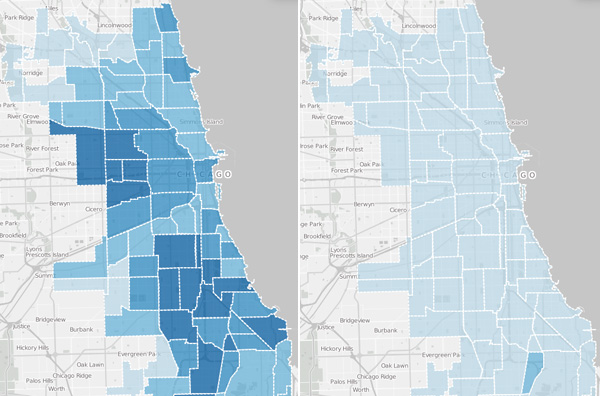
Photo: Bonnie Trafelet/Chicago Tribune
If you've been following my colleague Carol Felsenthal, you might have noticed that 49th ward alderman Joe Moore was scheduled to celebrate his 55th birthday with a "Champions of Change" award from the White House, for his implementation of participatory budgeting in his ward. An ill-timed report from legislative investigator general Faisal Khan put the brakes on that for now, as Moore described to Felsenthal.
Fortunately, there was another Chicagoan to pick up the slack in national recognition of open government in Chicago: Christopher Whitaker of the Smart Chicago Collaborative, one of 14 people recognized for their work in "Civic Hacking and Open Government."
The Smart Chicago Collaborative put together one of my favorite pieces of open-government dataviz recently, which is well worth a browse: the Chicago Health Atlas, which gathers health indicators from crime to low birth weight to blood lead levels across the city.
Take low-weight births, for example: there are substantial disparities across the city, from almost 20 percent in Avalon Park and Washington Heights to a low of 4.5 percent on the Lower West Side. Or elevated blood lead levels, which have fallen substantially; using the Atlas, here's a side-by-side comparison of 1999 and 2011:

There's a lot of (friendly) competition for open-data visualization in Chicago. Daniel X. O'Neil was also named a Champion of Change for his work, which includes muni-contract database CityPayments; city CTO John Tolva also received the award.
What sort of use is this work being put to? Predicting where the rats are in Chicago, for one:
For example, the analytics team found that in certain sections of Chicago, a 311 call or online request related to garbage produces a 7-day window in which an increased number of rodent calls will occur in the same area. Thus, rates of garbage-categorized 311 calls serve as a measurable indicator whose direction can signal changes in rat trends.
Also, leading indicator use as a prediction strategy can provide insight into the efficacy of seasoned rat-baiters’ traditional strategies. For example, rat-baiters have for years observed that a broken water main generally leads to an increase in rats in a given area. When taking their hunch to task with data, 311 inquiry analysis shows that the baiters are in fact correct.
And we're still in the very early stages of predictive analytics and open government; for an idea of where it's going, I talked to Rayid Ghani, former chief scientist of the Obama campaign, who's now at the University of Chicago leading up a fellowship program in Data Science for Social Good.


